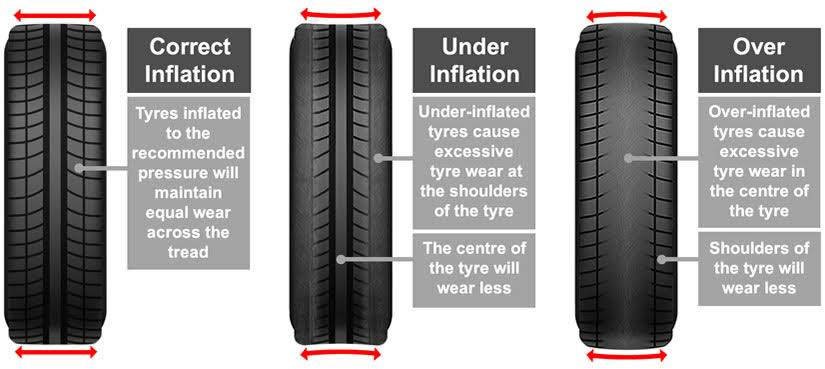Do you know how important tire pressure is for your car? Tire pressure is the amount of air that is inside your tires. It affects how your tires perform and how long they last. If your tire pressure is too high or too low, it can cause problems for your car and your safety.
In this article, we will explain how tire pressure affects the wear and tear of your tires, and how to check and adjust your tire pressure correctly. Let’s get started!
Tire pressure affects the wear and tear of your tires in two ways: by changing the shape of your tires and by changing the temperature of your tires.
When your tire pressure is too high, your tires become too hard and stiff. This makes the center of your tires bulge out and touch the road more than the sides. This causes the center of your tires to wear out faster than the sides. This can also make your ride uncomfortable and bumpy, and reduce your traction and braking ability.
When your tire pressure is too low, your tires become too soft and flexible. This makes the sides of your tires flatten and touch the road more than the center. This causes the sides of your tires to wear out faster than the center. This can also make your tires overheat and lose air faster, and increase your fuel consumption and emissions.
The best way to prevent these problems is to keep your tire pressure at the recommended level. This will make your tires wear evenly and last longer. It will also improve your ride quality and safety, and save you money on gas and repairs.
How to Check and Adjust Your Tire Pressure Correctly
To check and adjust your tire pressure correctly, you will need a tire pressure gauge and an air pump. You can buy these tools online or at a local auto parts store. You can also use the air pump at a gas station or a tire shop. Here are the steps to follow:
- Find out the recommended tire pressure for your car. You can find this information in your owner’s manual, on a sticker inside your driver’s door, or on the sidewall of your tires. The recommended tire pressure is usually measured in PSI (pounds per square inch) or kPa (kilopascals).
- Check your tire pressure when your tires are cold. This means that you should check your tire pressure before you drive your car or at least three hours after you drive your car. This is because driving your car heats up your tires and increases your tire pressure.
- Use the tire pressure gauge to measure your tire pressure. To do this, you will need to remove the valve cap from your tire and press the gauge firmly onto the valve stem. The gauge will show you the current tire pressure in PSI or kPa. You can compare this with the recommended tire pressure for your car.
- Adjust your tire pressure if needed. To do this, you will need to use the air pump to add or release air from your tires. If your tire pressure is too high, you can press the valve stem with your finger or a small tool to release some air. If your tire pressure is too low, you can connect the air pump to the valve stem and pump some air. You can check your tire pressure again with the gauge until it matches the recommended level.
- Replace the valve cap on your tire and repeat the process for the other tires. Make sure you check and adjust the tire pressure for all four tires, and also for the spare tire if you have one.
- Check your tire pressure regularly. You should check your tire pressure at least once a month, or more often if you drive a lot or in extreme weather conditions. You should also check your tire pressure before a long trip or when you carry heavy loads.
By following these steps, you can check and adjust your tire pressure correctly and prevent the wear and tear of your tires. This will help you to keep your tires in good shape and extend their lifespan. It will also help you to enjoy a smooth and safe ride, and save you money on gas and repairs.
Conclusion
Tire pressure is the amount of air that is inside your tires. It affects how your tires perform and how long they last. If your tire pressure is too high or too low, it can cause problems for your car and your safety. To prevent these problems, you should keep your tire pressure at the recommended level. This will make your tires wear evenly and last longer. It will also improve your ride quality and safety, and save you money on gas and repairs.
Read Also: How Airless Tires Can Change the Future of Driving
How Low Can Tire Pressure Be Before It Becomes Unsafe to Drive? (And Which Tires Can Still Go Flat?)

Comments (0)
Please login to join the discussion
Be the first to comment on this article!
Share your thoughts and start the discussion